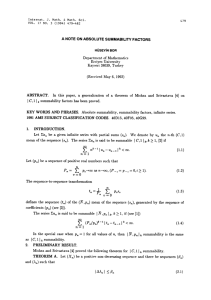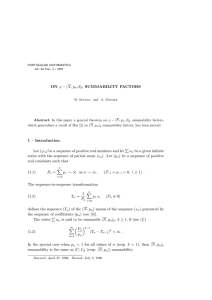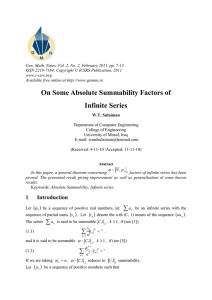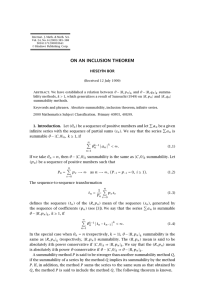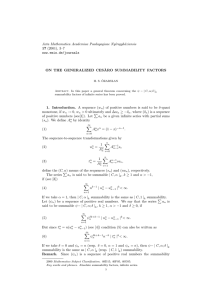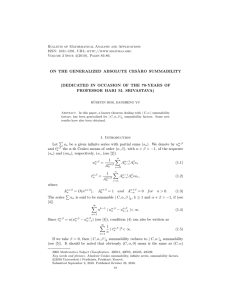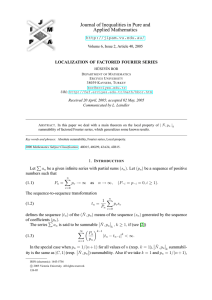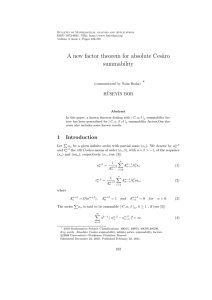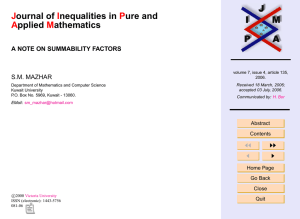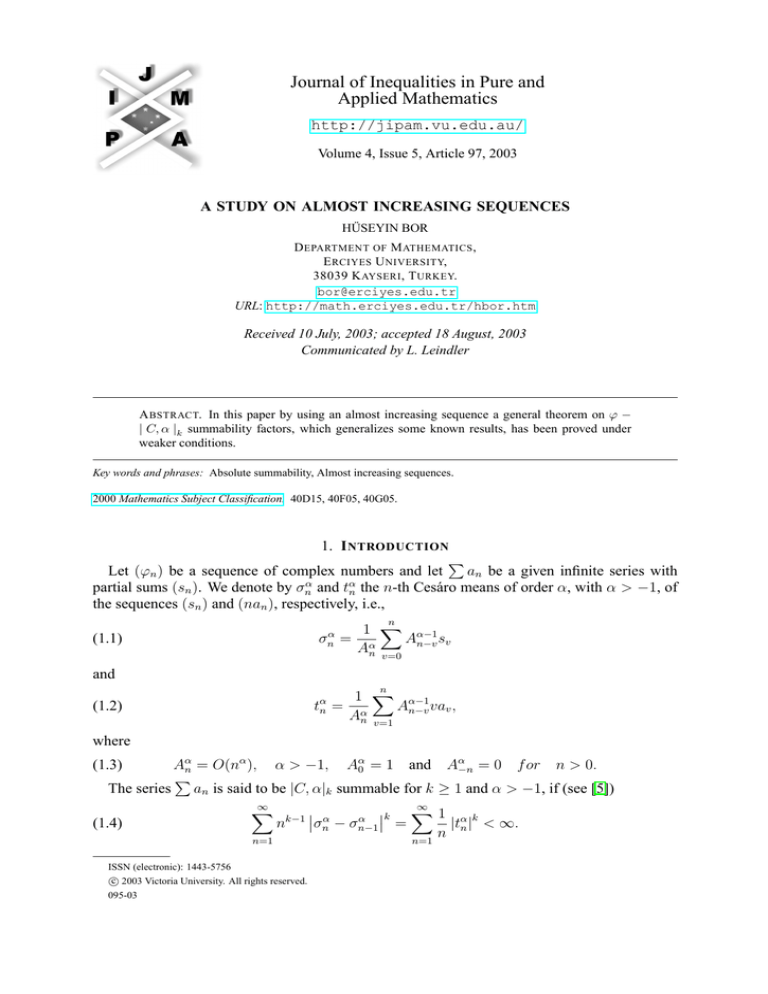
Journal of Inequalities in Pure and
Applied Mathematics
http://jipam.vu.edu.au/
Volume 4, Issue 5, Article 97, 2003
A STUDY ON ALMOST INCREASING SEQUENCES
HÜSEYIN BOR
D EPARTMENT OF M ATHEMATICS ,
E RCIYES U NIVERSITY,
38039 K AYSERI , T URKEY.
bor@erciyes.edu.tr
URL: http://math.erciyes.edu.tr/hbor.htm
Received 10 July, 2003; accepted 18 August, 2003
Communicated by L. Leindler
A BSTRACT. In this paper by using an almost increasing sequence a general theorem on ϕ −
| C, α |k summability factors, which generalizes some known results, has been proved under
weaker conditions.
Key words and phrases: Absolute summability, Almost increasing sequences.
2000 Mathematics Subject Classification. 40D15, 40F05, 40G05.
1. I NTRODUCTION
P
Let (ϕn ) be a sequence of complex numbers and let
an be a given infinite series with
α
α
partial sums (sn ). We denote by σn and tn the n-th Cesáro means of order α, with α > −1, of
the sequences (sn ) and (nan ), respectively, i.e.,
σnα
(1.1)
n
1 X α−1
= α
A sv
An v=0 n−v
and
tαn
(1.2)
n
1 X α−1
= α
A vav ,
An v=1 n−v
where
Aαn = O(nα ), α > −1, Aα0 = 1 and Aα−n = 0 f or n > 0.
P
The series an is said to be |C, α|k summable for k ≥ 1 and α > −1, if (see [5])
(1.3)
(1.4)
∞
X
n
k−1
n=1
ISSN (electronic): 1443-5756
c 2003 Victoria University. All rights reserved.
095-03
∞
X
α
1 αk
α k
σn − σn−1
=
|t | < ∞.
n n
n=1
2
H ÜSEYIN B OR
and it is said to be |C, α; β| k summable for k ≥ 1, α > −1 and β ≥ 0, if (see [6])
∞
∞
X
X
βk+k−1 α
α k
(1.5)
n
σn − σn−1 =
nβk−1 |tαn |k < ∞.
n=1
The series
(1.6)
P
n=1
an is said to be ϕ−|C, α|k summable for k ≥ 1 and α > −1, if (see [2])
∞
X
n−k |ϕn tαn |k < ∞.
n=1
1
1− k1
(resp. ϕn = nβ+1− k ) ϕ−|C, α|k summability is the same
In the special case when ϕn = n
as |C, α|k (resp. |C, α; β|k ) summability.
Bor [3] has proved the following theorem for ϕ−|C, 1|k summability factors of infinite series.
Theorem 1.1. Let (Xn ) be a positive non-decreasing sequence and let (λn ) be a sequence such
that
|λn | Xn = O(1)
(1.7)
as
n→∞
and
n
X
(1.8)
vXv ∆2 λv = O(1)
as
n → ∞.
v=1
If there exists an > 0 such that the sequence (n−k |ϕn |k ) is non-increasing and
n
X
(1.9)
v −k |ϕv tv |k = O(Xn ) as n → ∞,
v=1
then the series
P
an λn is ϕ−|C, 1|k summable for k ≥ 1.
The aim of this paper is to generalize Theorem 1.1 under weaker conditions for ϕ−|C, α|k
summability. For this we need the concept of almost increasing sequences. A positive sequence
(bn ) is said to be almost increasing if there exists a positive increasing sequence cn and two
positive constants A and B such that Acn ≤ bn ≤ Bcn (see [1]). Obviously every increasing
sequence is an almost increasing sequence but the converse need not be true as can be seen from
n
the example bn = ne(−1) . So we are weakening the hypotheses of the theorem by replacing the
increasing sequence with an almost increasing sequence.
2. R ESULT
Now, we shall prove the following:
Theorem 2.1. Let (Xn ) be an almost increasing sequence and the sequence (λn ) such that
conditions (1.7) – (1.8) of Theorem 1.1 are satisfied. If there exists an > 0 such that the
sequence (n−k |ϕn |k ) is non-increasing and if the sequence (wnα ), defined by (see [9])
α
α=1
| |tn | ,
α
(2.1)
wn =
max |tαv | , 0 < α < 1
1≤v≤n
satisfies the condition
m
X
(2.2)
n−k (wnα |ϕn |)k = O(Xm ) as
m → ∞,
n=1
then the series
P
an λn is ϕ−|C, α|k summable for k ≥ 1, 0 < α ≤ 1 and kα + > 1.
J. Inequal. Pure and Appl. Math., 4(5) Art. 97, 2003
http://jipam.vu.edu.au/
A S TUDY ON A LMOST I NCREASING S EQUENCES
3
We need the following lemmas for the proof of our theorem.
Lemma 2.2. ([4]). If 0 < α ≤ 1 and 1 ≤ v ≤ n, then
v
m
X
X
α−1
(2.3)
Aα−1
a
≤
max
A
a
p
p
n−p
m−p .
p=0
1≤m≤v p=0
Lemma 2.3. ([8]). If (Xn ) is an almost increasing sequence and the conditions (1.7) and (1.8)
of Theorem 1.1 are satisfied, then
m
X
(2.4)
Xn |∆λn | = O(1)
n=1
and
mXm |∆λm | = O(1),
(2.5)
m → ∞.
3. P ROOF OF T HEOREM 2.1
Let (Tnα ) be the n−th (C, α), with 0 < α ≤ 1, mean of the sequence (nan λn ). Then, by
(1.2), we have
n
1 X α−1
α
A vav λv .
Tn = α
An v=1 n−v
Using Abel’s transformation, we get
Tnα =
n−1
v
n
X
1 X
λn X α−1
α−1
∆λ
A
pa
+
An−v vav ,
v
p
n−p
α
Aαn v=1
A
n
p=1
v=1
so that making use of Lemma 2.2, we have
n−1
v
n
X
|λ | X
X
1
n
α
α−1
α−1
|Tn | ≤ α
|∆λv | An−p pap + α An−v vav p=1
An v=1
An v=1
≤
n−1
1 X α α
A w |∆λv | + |λn | wnα
Aαn v=1 v v
α
α
= Tn,1
+ Tn,2
,
Since
say.
α
α k α k
α k
Tn,1 + Tn,2
,
≤ 2k Tn,1
+ Tn,2
to complete the proof of the theorem, it is sufficient to show that
∞
X
α k
n−k ϕn Tn,r
< ∞ for r = 1, 2, by
(1.6).
n=1
Now, when k > 1, applying Hölder’s inequality with indices k and k 0 , where
get that
( n−1
)k
m+1
m+1
X
X
X
k
α n−k ϕn Tn,1
≤
n−k (Aαn )−k |ϕn |k
Aαv wvα |∆λv |
n=2
n=2
= O(1)
1
k
+
1
k0
= 1, we
v=1
m+1
X
( n−1
) ( n−1
)k−1
X
X
n−k n−αk |ϕn |k
v αk (wvα )k |∆λv |
|∆λv |
n=2
J. Inequal. Pure and Appl. Math., 4(5) Art. 97, 2003
v=1
v=1
http://jipam.vu.edu.au/
4
H ÜSEYIN B OR
= O(1)
m
X
v
αk
(wvα )k
v=1
= O(1)
m
X
m+1
X
n−k |ϕn |k
|∆λv |
nαk
n=v+1
v αk (wvα )k |∆λv |
v=1
= O(1)
= O(1)
= O(1)
m
X
v=1
m
X
v=1
m
X
v
αk
(wvα )k
m+1
X
n−k |ϕn |k
nαk+
n=v+1
|∆λv | v
−k
m+1
X
k
|ϕv |
1
n=v+1
v
αk
(wvα )k
|∆λv | v
−k
k
Z
∞
|ϕv |
nαk+
dx
xαk+
v
v |∆λv | v −k (wvα |ϕv |)k
v=1
= O(1)
m−1
X
∆(v |∆λv |)
v
X
v=1
r−k (wrα |ϕr | )k
r=1
+ O(1)m |∆λm |
m
X
v −k (wvα |ϕv |)k
v=1
= O(1)
m−1
X
|∆(v |∆λv |)| Xv + O(1)mβm Xm
v=1
= O(1)
m−1
X
m−1
X
2 v ∆ λv Xv + O(1)
|∆λv+1 | Xv+1 + O(1)m |∆λm | Xm
v=1
= O(1)
v=1
m → ∞,
as
by virtue of the hypotheses of Theorem 2.1 and Lemma 2.3.
Again, since |λn | = O(1/Xn ) = O(1), by (1.7), we have that
m
X
n
−k
m
X
α k
ϕn Tn,2
=
|λn |k−1 |λn | n−k (wnα |ϕn |)k
n=1
n=1
= O(1)
m
X
|λn | n−k (wnα |ϕn |)k
n=1
= O(1)
m−1
X
∆ |λn |
n=1
= O(1)
m−1
X
n
X
v
−k
(wvα
k
|ϕv |) + O(1) |λm |
m
X
n−k (wnα |ϕn |)k
n=1
v=1
|∆λn | Xn + O(1) |λm | Xm = O(1)
as
m → ∞,
n=1
by virtue of the hypotheses of Theorem 2.1 and Lemma 2.3.
Therefore, we get that
m
X
α k
= O(1)
n−k ϕn Tn,r
as
m → ∞,
for
r = 1, 2.
n=1
This completes the proof of the theorem.
J. Inequal. Pure and Appl. Math., 4(5) Art. 97, 2003
http://jipam.vu.edu.au/
A S TUDY ON A LMOST I NCREASING S EQUENCES
5
4. S PECIAL C ASES
1
1. If we take (Xn ) as a positive non-decreasing sequence, α = 1 and ϕn = n1− k in
Theorem 2.1, then we get Theorem 1.1.
1
2. If we take (Xn ) as a positive non-decreasing sequence, α = 1 and ϕn = n1− k in
Theorem 2.1, then we get a result due to Mazhar [7] for |C, 1|k summability factors of
infinite series.
1
1
3. If we take = 1 and ϕn = n1− k (resp. = 1 and ϕn = nβ+1− k ), then we get a new
result related to |C, α|k (resp. |C, α; β|k ) summability factors.
R EFERENCES
[1] S. ALJANCIC
(1977), 5–22.
AND
D. ARANDELOVIC, O-regularly varying functions, Publ. Inst. Math., 22
[2] M. BALCI, Absolute ϕ-summability factors, Comm. Fac. Sci. Univ. Ankara, Ser. A1 , 29 (1980),
63–80.
[3] H. BOR, Absolute summability factors, Atti Sem. Mat. Fis. Univ. Modena, 39 (1991), 419–422.
[4] L.S. BOSANQUET, A mean value theorem, J. London Math. Soc., 16 (1941), 146–148.
[5] T.M. FLETT, On an extension of absolute summability and some theorems of Littlewood and Paley,
Proc. London Math. Soc., 7 (1957), 113–141.
[6] T.M. FLETT, Some more theorems concerning the absolute summability of Fourier series, Proc.
London Math. Soc., 8 (1958), 357–387.
[7] S.M. MAZHAR, On |C, 1|k summability factors, Indian J. Math., 14 (1972), 45–48.
[8] S.M. MAZHAR, Absolute summability factors of infinite series, Kyungpook Math. J., 39 (1999),
67–73.
[9] T. PATI, The summability factors of infinite series, Duke Math. J., 21 (1954), 271–284.
J. Inequal. Pure and Appl. Math., 4(5) Art. 97, 2003
http://jipam.vu.edu.au/


